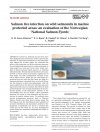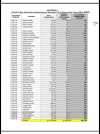Unfortunately, not a surprise, GF. That's how this whole "
We gotta have an act of our own to exempt us from environmental oversight" thing started.
It all started after the Morton decision (2009), and DFO and the feds got handed back regulation for the industry. Must've been quite the strategy meetings afterwards by the PR companies and the BCSFA & CAIA. Would have been interesting to be a bird on the wall listening in.
In 2010, CAIA (Canadian Aquaculture Industry Alliance) wrote a letter to DFO pushing for a separate federal aquaculture statute and clearer property rights for aquaculturists (
http://epe.lac-bac.gc.ca/100/206/30...OCALHOS/EXHIBITFILES/EXH_1626___CAN384486.ZIP).
This initiative was supported and driven up the ladder in DFO by upper-level DFO managers (e.g. Trevor Swerdfager & James Smith). All of this is outlined in the Cohen exhibits. Would have been interesting to be a bird on the wall listening in there too when the FF lobbyists were having those closed door meetings with upper-level DFO.
By 2013 – Pamela Parker (executive director of the Atlantic Canada Fish Farmers Association) who also later testified at the Senate Committee hearings on aquaculture that proposed a new Aquaculture Act by 2016) was lobbying for a “New Aquaculture Strategy” by 2013.
They did get their way already through the "
Aquaculture Activities Regulations" (AAR) which ended-up exempting the industry from the "Release of a Deleterious Substance" provisions of the Fisheries Act. Originally, those regulations were supposed to do many things - including setting sea lice levels and other environmental issues. AFTER consultations - the industry got it's way as they have been used to doing - and those regulations were hollowed-out to merely exempt industry from s. 36 of the Fisheries Act for their sea lice treatments since it was apparent by then that slice in the feed was not working due to sea lice resistance to it's effects.
Later in 2018, the Commissioner of the Environment and Sustainable Development found the AAR deficient in both their design and implementation (not a surprise, neither). Specifically, the Commissioner found that DFO did not assess whether the AARs were adequate to minimize harm to wild fish, that DFO was not validating the information in the industry self-reports, and that the AAR were not sufficiently enforced to minimize harm to wild fish:
https://www.dfo-mpo.gc.ca/ae-ve/evaluations/16-17/96031-eng.html
I'm hoping this newest consultation is not merely smoke and mirrors so they can push through what the industry always wanted, 10+ years ago. It sure highlights the conflicts of interest in having the promotor and booster also be the regulator.






www.northislandgazette.com





